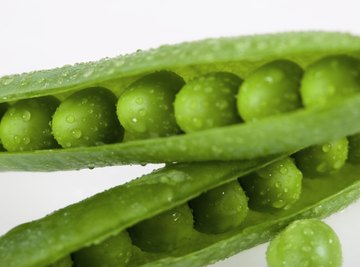
The term “heterozygous” refers to a pair of particular genes, or alleles, one of which you inherit from each parent. Genes contain the genetic information that codes for the proteins that express your traits. When the two alleles are not identical, the pair is heterozygous. In contrast, an identical pair is homozygous. The traits actually expressed by a heterozygous pair of alleles depend on the relationship between the two alleles and possibly the effects of other genes.
Gregor Mendel
In the 1860s, Silesian monk Gregor Mendel performed extensive experiments with pea plants to figure out the relationships between parent and offspring traits. He created many lines of pea plants, one in which round-pea varieties were crossed with only other round-pea varieties over several generations to ensure that he had a plant purebred for the trait. He did the same for wrinkled-pea varieties. He then crossbred parents of the two types and found that 100 percent of the offspring were the round-pea variety. He called these offspring the F1 generation.
Dominant and Recessive Traits
Mendel deduced the explanation for the F1 results. He determined that each parent had two factors -- what we now call genes -- for a trait such as pea shape, and that one gene dominated the other. He assigned the label RR to the round-pea parents and ww to the wrinkled-pea parents. Each offspring had one of each gene -- the Rw allele pair -- and because R dominates w, all four heterozygous offspring had the round-pea dominant trait. Mendel then crossed F1 parents and recorded the F2 generation results.
Mendel’s Laws
In the F2 generation, 75 percent had round peas and 25 percent were of the wrinkled type. That is, the cross Rw + Rw produced 25 percent homozygous RR, 50 percent heterozygous Rw and 25 percent homozygous ww. Only the ww offspring could express wrinkled peas because the trait is recessive. Mendel formulated his laws of dominance, segregation and independent assortment based on the idea of paired factors that segregate independently into sex cells, or gametes, and that join independently during fertilization. For example, an Rw plant can produce R gametes and w gametes. At fertilization, the random joining of two gametes produces the allele pair of the offspring, yielding traits based on their dominant-recessive relationship.
Codominance

Today we know that not all heterozygous allele pairs display a pure dominant-recessive relationship. As a second example of a heterozygous trait, consider human blood types. The three allele possibilities are types A, B and O. A and B are codominant; O is recessive. The heterozygote AO gives type A blood, while BO gives type B blood. However, the AB heterozygote gives the unique AB blood type. Since both A and B are codominant, each is expressed in the blood type trait, creating a new, unique type.
References
About the Author
Based in Greenville SC, Eric Bank has been writing business-related articles since 1985. He holds an M.B.A. from New York University and an M.S. in finance from DePaul University. You can see samples of his work at ericbank.com.
Photo Credits
Polka Dot Images/Polka Dot/Getty Images
